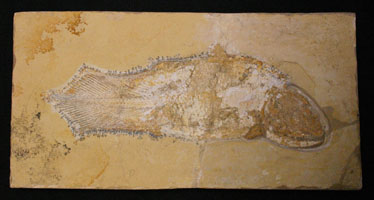Holophagus penicillatus, also known as Undina penicillata, was a Coelacanth from the lithographic limestone beds of Solnhofen, Bavaria, Germany. These limestone beds are the result of a series of islands and shallow lagoons. The fine grained sediments in these lagoons produced nearly flawless remains of the plants and animals which fell or were washed into them as well as some of their natural inhabitants.
Coelacanths have existed for over 400 million years. It was once believed to be the link between fish and land animals, because of its two pairs of lobed fins. Evolutionists believed that these lobed fins evolved into legs, allowing the transition to amphibians and then to land dwelling reptiles. Studies to date show that the Coelacanth has changed very little over this vast number of years. It was thought to have been extinct for about 70 million years, until a live specimen was caught, in 1938, off the coast of Africa, in the Indian Ocean, and has since also been found in Indonesia. It is possible that all of the Coelacanths that lived in the shallow waters died when the meteor hit at the end of the Cretaceous. Those species that lived at great depths survived the impact and are still alive today.
The tail of the Coelacanth, caudal fin, is diphycercal (meaning divided into three lobes). The middle lobe is a continuation of the notocord. Coelacanath, means hollow spine in Greek (coelia-meaning hollow and acanthus-meaning spine).
Kingdom: Animalia, Phylum: Chordata, Class: Sarcopterygii, Order: Coelacanthiformes, Family: Latimeriidae, Genus: Holophagus, Species: penicillatus.
Retail for this rare Solnhofen Coelacanth is $7,000.00.
This specimen is being offered from a private collection!
Coelacanth: Holophagus penicillatus 
Quantity in Basket: None
Code: OCF-401
Price: $7,000.00
Shipping Weight: 7.00 pounds
Species: Holophagus penicillatus
Time: Late Jurassic, 160-140 million years ago
Location: Solnhofen Plattenkalk, Bavaria, Germany
Dimensions: 12-1/8" x 6-1/4" x 3/4"